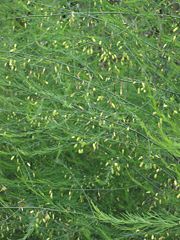Asparagales
| Asparagales Fossil range: 100 Ma middle Cretaceous - Recent |
||||||||
|---|---|---|---|---|---|---|---|---|
 |
||||||||
| Scientific classification | ||||||||
|
||||||||
| Families | ||||||||
|
See text |
Asparagales is an order of flowering plants. The order must include the family Asparagaceae, but other families included in the order have varied markedly between different classifications. No one is sure, but it is supposed that this group of plants evolved between late and early Cretaceous. But because of the difficult classification of the families it's not entirely certain when they evolved.
Contents |
APG II system
The APG II system of 2003, places the order in the clade monocots and uses the following circumscription:
- order Asparagales
- family Alliaceae
- [+ family Agapanthaceae]
- [+ family Amaryllidaceae]
- family Asparagaceae
- [+ family Agavaceae]
- [+ family Aphyllanthaceae]
- [+ family Hesperocallidaceae]
- [+ family Hyacinthaceae]
- [+ family Laxmanniaceae]
- [+ family Ruscaceae]
- [+ family Themidaceae]
- family Asteliaceae
- family Blandfordiaceae
- family Boryaceae
- family Doryanthaceae
- family Hypoxidaceae
- family Iridaceae
- family Ixioliriaceae
- family Lanariaceae
- family Orchidaceae
- family Tecophilaeaceae
- family Xanthorrhoeaceae
- [+ family Asphodelaceae]
- [+ family Hemerocallidaceae]
- family Xeronemataceae
- family Alliaceae
Note: "+ ..." = optional segregrate family, that may be split off from the preceding family.
APG II has consolidated some of the families in the earlier APG system, while recognizing an alternative, that allows smaller families to be seggregated and still follow the 'APG system'. Under the new classification system a taxonomist could, for example, correctly choose to include the daylilies (Hemerocallis) in family Hemerocallidaceae, or in family Xanthorrhoeaceae.
APG system (1998)
The APG system of 1998 also placed the order in the clade monocots but used this circumscription:
- order Asparagales
- family Agapanthaceae
- family Agavaceae
- family Alliaceae
- family Amaryllidaceae
- family Anemarrhenaceae
- family Anthericaceae
- family Aphyllanthaceae
- family Asparagaceae
- family Asphodelaceae
- family Asteliaceae
- family Behniaceae
- family Blandfordiaceae
- family Boryaceae
- family Convallariaceae
- family Doryanthaceae
- family Hemerocallidaceae
- family Herreriaceae
- family Hyacinthaceae
- family Hypoxidaceae
- family Iridaceae
- family Ixioliriaceae
- family Lanariaceae
- family Laxmanniaceae
- family Orchidaceae
- family Tecophilaeaceae
- family Themidaceae
- family Xanthorrhoeaceae
- family Xeronemataceae
Kubitzki system
The volume (1998) in the Kubitzki series of reference books on vascular plants used this circumscription:
- order Asparagales
- family Agapanthaceae
- family Agavaceae
- family Alliaceae
- family Amaryllidaceae
- family Anemarrhenaceae
- family Anthericaceae
- family Aphyllanthaceae
- family Asparagaceae
- family Asphodelaceae
- family Asteliaceae
- family Behniaceae
- family Blandfordiaceae
- family Boryaceae
- family Convallariaceae
- family Doryanthaceae
- family Dracaenaceae
- family Eriospermaceae
- family Hemerocallidaceae
- family Herreriaceae
- family Hyacinthaceae
- family Hostaceae
- family Hypoxidaceae
- family Iridaceae
- family Ixioliriaceae
- family Johnsoniaceae
- family Lanariaceae
- family Lomandraceae
- family Nolinaceae
- family Orchidaceae
- family Ruscaceae
- family Tecophilaeaceae
- family Themidaceae
- family Xanthorrhoeaceae
Dahlgren system
The Dahlgren system placed the order in superorder Lilianae in subclass Liliidae [= monocotyledons] of class Magnoliopsida [= angiosperms] and used this circumscription:
- order Asparagales
- family Agavaceae
- family Alliaceae
- family Amaryllidaceae
- family Anthericaceae
- family Aphyllanthaceae
- family Asparagaceae
- family Asphodelaceae
- family Asteliaceae
- family Blandfordiaceae
- family Calectasiaceae
- family Convallariaceae
- family Cyanastraceae
- family Dasypogonaceae
- family Doryanthaceae
- family Dracaenaceae
- family Eriospermaceae
- family Hemerocallidaceae
- family Herreriaceae
- family Hostaceae
- family Hyacinthaceae
- family Hypoxidaceae
- family Ixioliriaceae
- family Lanariaceae
- family Luzuriagaceae
- family Nolinaceae
- family Philesiaceae
- family Phormiaceae
- family Ruscaceae
- family Tecophilaeaceae
- family Xanthorrhoeaceae
Other systems
The Cronquist system did not recognise the order, and placed many of the plants involved in order Liliales (in subclass Liliidae in class Liliopsida [= monocotyledons]). Some genera were even included in family Liliaceae.
The Wettstein system, last revision of 1935, did not recognise such an order, and placed many of the plants involved in order Liliiflorae in class Monocotyledones.
References
- Kubitzki, K. (1998). Conspectus of Families treated in this Volume. In: Kubitzki, K.(Editor): The Families and Genera of Vascular Plants, Vol.3. Springer-Verlag. Berlin, Germany. ISBN 3-540-64060-6